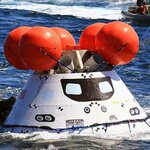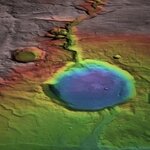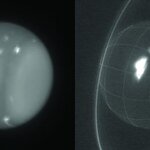Space

The highly anticipated maiden flight of NASA's next-generation Orion spacecraft is just hours away. Orion is slated to lift off Thursday, igniting a chase for America's dream of space exploration where no human has ever been, just like in 1969, setting foot on the Moon. Now, it's a start for a journey far beyond, to Mars via asteroids, and to recover space pioneering aspirations. But before reaching other worlds, much work must be done, a series of test to get Orion in shape for future spaceflight assignments. The key task is returning astronauts down to Earth safely, without any…

Sci-fi realities Mark Bult, CC BY-ND
By Ian Crawford, Birkbeck, University of London
To date, all human economic activity has depended on the material and energy resources of a single planet; understandably, perhaps.
It is conceivable though that future advances in space exploration could change this by opening our closed planetary economy to essentially unlimited external resources of energy and raw materials.
Look up at the Moon this evening, and you might be gazing at a solution. The Earth’s closest celestial neighbor seems likely to play a major role and already a number of…

There’s really a more productive way to spend Black Friday instead of going berserk and storming the stores. A really huge crowd of 90,000 people capable of invading every bigger mall during the yesterday’s run-and-buy frenzy, has made history sending greetings to our reddish neighboring planet. “Today uwingu.com sent almost 90,000 messages to Mars—first time people’s names&messages sent to Mars by radio!” the Uwingu company which crowd funds space projects, said on Twitter. It was a global shout-out event to mark the 50th anniversary of NASA’s Mariner 4 - the first…

On Nov. 22, 2014 from 5:29 to 6:04 p.m. EST., the moon partially obscured the view of the sun from NASA's Solar Dynamics Observatory (SDO), orbiting more than 22,000 miles above our planet's surface. This phenomenon, which is called a lunar transit, could only be seen from SDO's point of view. In 2014, SDO captured four such transits - including its longest ever recorded, which occurred on Jan. 30, and lasted two and a half hours. SDO imagery during a lunar transit always shows a crisp horizon on the moon - a reflection of the fact that the moon has no atmosphere around it to distort the…

Communications with NASA's STEREO Behind spacecraft were interrupted on October 1, 2014 immediately after a planned reset of the spacecraft performed as part of a test of solar conjunction operations. There have been no successful communications since then, though attempts to recover the spacecraft continue. The spacecraft telemetry indicated an anomaly in the guidance and control system, but this is still being evaluated. Initial indications are that a series of problems in the guidance and control system led to the anomaly. Because both STEREO spacecraft are now on the far side of the Sun…
The Earth has a magnetic field that functions as an in-built force-field against galactic cosmic rays, particles from space which prompt a chain-reaction of events in thunderclouds that trigger lightning bolts.
The only thing more powerful than our magnetic field is that of the Sun, and it may be playing a part in the generation of lightning strikes on Earth by temporarily 'bending' the Earth's magnetic field and allowing more energetic particles to enter the upper atmosphere. Over a five year period, the UK experienced around 50% more lightning strikes and researchers found that…

There are cosmic alignments over the largest structures ever discovered in the Universe - the rotation axes of the central supermassive black holes in quasars billions of light years apart are parallel to each other.
Quasars are galaxies with very active supermassive black holes at their centers. These black holes are surrounded by spinning discs of extremely hot material that is often spewed out in long jets along their axes of rotation. Quasars can shine more brightly than all the stars in the rest of their host galaxies put together.
A team led by Damien Hutsemékers from the…

The formation of stars of mass greater than 8 times that of the Sun occurs in distant and very obscured areas of the sky. To form a massive star requires a massive and dense interstellar cloud. To see what is going on there requires more than an optical telescope. We rely on intense and compact sources of radio emission, masers. Inquiry into the formation of massive stars is a very active area of astronomy. Do they form based on a beefed up version of the disk-outflow model which works for less massive stars, or do they form by accretion and collision of smaller…

It is known that at some point Mars was warm enough to have liquid water flowing on its surface. The evidence of ancient rivers, streams, and lakes remains.
But it was not a long-term tropical vacation paradise. Instead, warmth and water flow on ancient Mars was probably episodic, related to brief periods of volcanic activity that spewed tons of greenhouse-inducing sulfur dioxide gas into the atmosphere, according to new climate models of early Mars which suggest that periods of temperatures warm enough for water to flow likely lasted for only tens or perhaps hundreds of years at a time.
The…

Uranus is generally boring but it recently got interesting. It has become so stormy, with enormous cloud systems so bright, that for the first time ever amateur astronomers are able to see details in the planet's hazy blue-green atmosphere.
Astronomers detected eight large storms on Uranus's northern hemisphere while observing the planet with the Keck Telescope on August 5th and 6th. One was the brightest storm ever seen on Uranus at 2.2 microns, a wavelength that senses clouds just below the tropopause, where the pressure ranges from about 300 to 500 mbar, or half the pressure at Earth's…